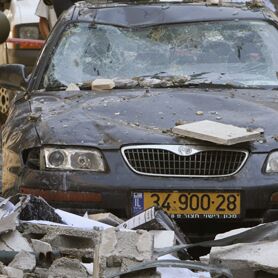
Hezbollah’s Terrorizing Missiles
During the Hezbollah-Israel war the world was bombarded with sound-bites, images and headlines of Lebanese civilian deaths. Exploiting the situation, Hezbollah and its accomplices saw to it that photo opportunities abounded. In appalling disrespect for the dead, Hezbollah fighters and rescue workers would think nothing of posing with dead bodies for over an hour to maximize their propaganda value.
Israeli civilian deaths—not caused inadvertently during the messy task of conducting a war, but rather by a deliberate strategy of terrorizing and murdering civilians—were largely hidden from view. So too was the terrifying ordeal of living under constant threat of indiscriminate missile attacks.
Perhaps the notion of terrorists’ rockets conjures up an image of a rather primitive weapon, able to cause little harm. Not so; in fact, not only had Hezbollah obtained sophisticated missiles, but had them modified to inflict maximum damage to people.Kenneth Timmerman described the lethality of Hezbollah’s rockets in an article on FrontPageMagazine.com:
These Iranian-made Fajr-3 rockets have a range of around 43 kilometers, and carry a 50 kilogram warhead packed with thousands of deadly ball bearings.
These are terrorist mass-kill weapons, designed to kill as many civilians as possible. No one standing within a 50-meter radius of one of these incoming rockets can survive, Israeli bomb experts say. The Fajr-3 was used with great success in a July 16 attack that killed eight railway workers at a repair depot in downtown Haifa. ”When they showed me the small pellets packed inside, I thought they were showing me a suicide bomber belt,” Haifa mayor Yona Yahav told me. In fact, Iran modeled the design of the Fajr-3 warhead on the suicide bomber belts, with the clear aim of maximizing its lethality. Syria supplied similar rockets to Hezbollah, packed with ball bearings. Hezbollah purchased smaller rockets from Communist China, after they had been similarly modified.
No wonder the Israeli streets became deserted, hundreds of thousands fleeing south and the rest largely holing up underground. It was this fact, together with Israeli warning systems that in some cases gave people upwards of a minute to flee to safety, that prevented more-massive casualties. As it was, 43 Israeli civilians became the victims of Hezbollah rocket attacks and a further 1,489 were injured, 33 of those being seriously wounded. In addition, 2,773 were treated for shock and anxiety.
Consider, for example, the effect Hezbollah’s terror-inducing weapons had on Haifa, Israel’s third-largest city, where downtown turned into a virtual ghost town, and the port became completely deserted. From Haifa, David Aikman wrote:
Compared with the northern part of Israel as a whole, where some 1 million people have lived in shelters since the rockets started falling, Haifa’s suffering might not, at first sight, seem very onerous. But the scenes of destruction, bloodshed, and chaos at the explosion sites of Katyushas, as the Hezbollah rockets are called, are terrifying. One half of a three-story building in the city’s Bat Galim district was totally demolished when it was struck by a 220-mm caliber rocket—the preferred Hezbollah ordnance for Haifa, because it can travel further and carry more explosives. An amateur videographer a few houses away caught the devastation a few seconds after impact as a corpse hung crumpled over in a chair teetering on the blown-out edge of the second floor. The façades of houses across the street and street signs 50 yards away were peppered with clean holes from the warhead’s 30,000 ball bearings, which fan out on impact and can blast clean through thick steel, the better to kill as many civilians as possible.
The barrage of rockets has now ceased, but for the residents of Haifa—and hundred of thousand of other Israelis—to think that Hezbollah still has thousands of these weapons of terror, and likely worse, stocked away certainly cannot be a comforting thought.
